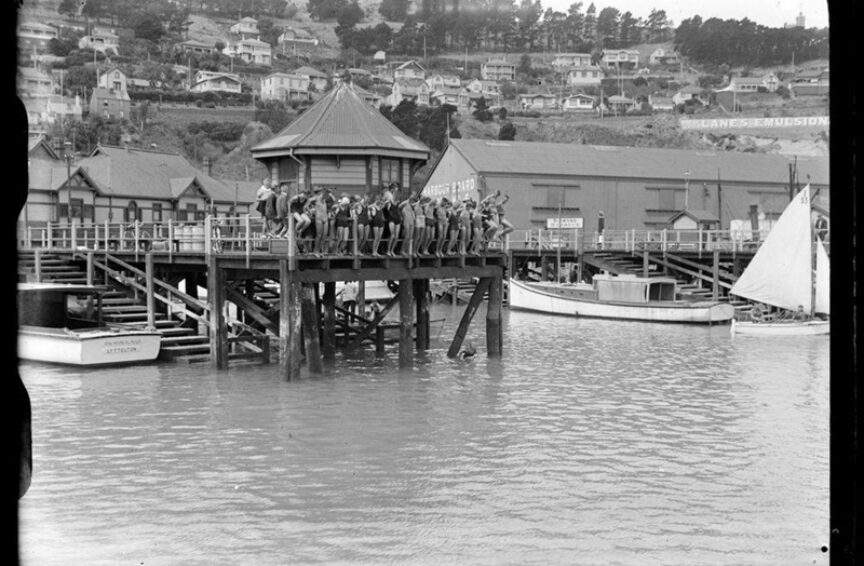PO Box 95
Lyttelton 8841
Te Ūaka recognises Te Hapū o Ngāti Wheke as Mana Whenua and Mana Moana for Te Whakaraupō / Lyttelton Harbour.
The Lyttelton Harbour Board's Cool Store
On or around 5 January 1905 in the port of Lyttelton, 3,486 boxes of Te Waipounamu South Island butter, totaling 1,743 Hundredweight (CWT) or 88.5 tonnes, along with 185 cases of fine Canterbury cheese, weighing an additional 214 CWT (1.1 tonne), were unpacked from the Lyttelton Harbour Board's (LHB) cool store adjacent to the rail yard between No.6 and No.7 wharves. The rounded many-faceted cheese crates each contained two round cheeses separated by a board the same shape as the ends, giving strength to the case. Being round the cases could be rolled on the edge of the base like a barrel. The lengthwise boards featured slight gaps for ventilation, allowing testers to insert tubes for core samples. This testing regime was required to both grade the cheese and ensure it was at a stable temperature of around 45 degrees Fahrenheit (7 degrees Celsius) while in cool storage before being loaded for transport.
Hauled by LHB workers onto flatbed rail cars which were then drawn by the railway workers’ horses onto the wharf, these dairy products were loaded by the watersiders into the refrigerated hold of the SS Ruapehu, operated by the New Zealand Shipping Company, and destined for the London markets. This refrigerated dairy trade with the Motherland was an economic boon for the Dominion of New Zealand. Almost a decade later, by April 1914, the quantity of butter awaiting export in port-side cool stores around the country totaled 88,062 boxes (2,237 tonnes), a year on year increase of 37%, reflecting the huge growth in Aotearoa New Zealand’s early 20th century export dairy industry. This growth was made possible by the invention and industrial use of mechanical refrigeration just three decades earlier in the early 1880s.
The ancient world, from the Romans to the Persians and Chinese, harvested and stored ice for their refrigeration needs, and also used evaporative cooling. These methods continued well into the 19th century until innovations in steam driven compressed gas refrigeration technology proved their profitability. The Australasian colonies of the British Crown were at the forefront of this technological drive due to the need to trade frozen meat and dairy products with their biggest markets on the other side of the planet. Queenslander Thomas McIlwraith delivered the first shipment of 40 tons of unspoilt frozen Australian beef and mutton to London in 1879 using a patented ‘Bell-Coleman’ gas refrigeration unit on board the Strathleven.
Then in 1882, Scotsmen Davidson and Brydone managed New Zealand’s inaugural shipment of 4909 frozen mutton and lamb carcasses from Totara Estate near Oamaru, on board the Dunedin out of Port Chalmers to London, marking a pivotal moment for the colony’s struggling economy. This achievement, coupled with subsequent profitable voyages, laid the foundation for the worldwide refrigerated shipping industry, transforming Aotearoa New Zealand's economy by making frozen meat and dairy exports a cornerstone of the colony’s late 19th into 20th-century economic prosperity.
In 1889, the Canterbury Frozen Meat and Dairy Produce Export Company opened the Belfast Freezing Works for meat due for export out of Lyttelton port. The following October 1890, the LHB’s Committee on Cool Chambers suggested repurposing the port’s Grain Agency shed as a cool store, and urged the Government to appoint an expert for butter and cheese inspection in Canterbury. The export of dairy produce out of Lyttelton port in 1889 was worth £52,473 ($17 million NZD) but it was believed to be a fraction of the Canterbury dairy industry's potential.
In early 1891, the LHB decided that spending £5,000 ($1.6 million NZD) on a cool store for Lyttelton port would accelerate the industry's growth, even if the returns on the investment were not immediately apparent. The development of the cool store was accelerated when in July 1891, The Grocer, a prominent trade journal in the United Kingdom, expressed serious concerns about the condition of New Zealand butter and cheese during long voyages, advocating for quarantine measures and proper cool-chamber conditions, otherwise the “dairying industry in New Zealand is threatened with partial, if not complete, collapse!” – Lyttelton Times, 18 August 1891.
By 30 June 1893, a storage rate of 1s 6d per imperial ton was in effect at the newly built Lyttelton Harbour Board Cool Store for handling produce destined for the rapidly growing refrigerated export market. Almost a quarter of a century later in 1916, the Public Works Department announced the imminent activation of an electrical substation at the cool store. Plans for electrifying the town followed, with an initial phase providing electricity from Norwich Quay through to London Street, up Canterbury and Oxford streets to Winchester, Dublin and Exeter streets, at a capital outlay of £750 ($164,000 NZD). Thus it was that a modernised cool store helped extinguish Ōhinehou Lyttelton’s gas lamps and usher in the electric 20th century.
Many thanks to Lex Calder for his notes on the port workers of Whakaraupō Lyttelton Harbour.

